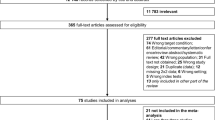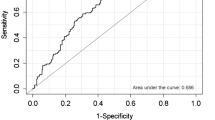Abstract
Background
The benefit of post-urinary tract infection (UTI) sonography to detect clinically significant renal abnormalities remains a subject open to debate. Decision curve analysis (DCA) is a novel method for evaluating the clinical usefulness of diagnostic tests. Our objective was to determine, using DCA, the benefit of post-UTI sonography and of post-UTI sonography with biological markers of inflammation to predict the risk of recurrence of febrile UTI in children aged 2 to 24 months without known uropathy.
Methods
We retrospectively analyzed all children aged 2 to 24 months, without known uropathy, who presented with a first episode of febrile UTI between 2009 and 2012 and followed them for 30 months. We then used DCA to estimate the benefit of post-UTI sonography or post-UTI sonography + biological markers of inflammation for detecting the risk of recurrence.
Results
A total of 318 children [144 boys (45.3 %) and 174 girls (54.7 %)], with a mean age of 6.9 ± 5.6 months, were identified. Of these, 210 children presented with a significant inflammation [66.2 %; 95 % confidence interval (CI) 61.0–71.4], and 30 (9.4 %; 95 % CI 6.2–12.6) presented with abnormal post-UTI sonographic findings. Eighteen (5.7 %; 95 % CI 3.1–8.2) children presented with recurrent UTI at 30 months.
Conclusions
There were significantly more recurrences in those children who presented with abnormal sonographic findings than in those who did not (relative risk 7.68; 95 % CI 3.03–19.46). However, taking into account the effect of false-positives and false negatives, the DCA revealed that for threshold probabilities of >30 %, at which patients/doctors are concerned about unnecessary interventions (whether tests or treatments), neither post-UTI sonography nor post-UTI sonography + biological markers of inflammation have sufficient value to improve care.

Similar content being viewed by others
References
Newman TB (2011) The new American Academy of Pediatrics urinary tract infection guideline. Pediatrics 128:572–575
Jodal U, Smellie JM, Lax H, Hoyer PF (2006) Ten-year results of randomized treatment of children with severe vesicoureteral reflux. Final report of the International Reflux Study in Children. Pediatr Nephrol 21:785–792
Craig JC, Simpson JM, Williams GJ, Lowe A, Reynolds GJ, McTaggart SJ, Hodson EM, Carapetis JR, Cranswick NE, Smith G, Irwig LM, Caldwell PH, Hamilton S, Roy LP (2009) Antibiotic prophylaxis and recurrent urinary tract infection in children. N Engl J Med 361:1748–1759
Economou G, Egginton JA, Brookfield DS (1994) The importance of late pregnancy scans for renal tract abnormalities. Prenat Diagn 14:177–180
Alon US, Ganapathy S (1999) Should renal ultrasonography be done routinely in children with first urinary tract infection? Clin Pediatr (Phila) 38:21–25
Miron D, Daas A, Sakran W, Lumelsky D, Koren A, Horovitz Y (2007) Is omitting post urinary-tract-infection renal ultrasound safe after normal antenatal ultrasound? An observational study. Arch Dis Child 92:502–504
Preda I, Jodal U, Sixt R, Stokland E, Hansson S (2010) Value of ultrasound in evaluation of infants with first urinary tract infection. J Urol 183:1984–1988
Montini G, Zucchetta P, Tomasi L, Talenti E, Rigamonti W, Picco G, Ballan A, Zucchini A, Serra L, Canella V, Gheno M, Venturoli A, Ranieri M, Caddia V, Carasi C, Dall’amico R, Hewitt I (2009) Value of imaging studies after a first febrile urinary tract infection in young children: data from Italian renal infection study 1. Pediatrics 123:e239–e246
Montini G, Tullus K, Hewitt I (2011) Febrile urinary tract infections in children. N Engl J Med 365:239–250
Stein R, Dogan HS, Hoebeke P, Kocvara R, Nijman RJ, Radmayr C, Tekgul S (2015) Urinary tract infections in children: EAU/ESPU guidelines. Eur Urol 67:546–558
Corteville JE, Gray DL, Crane JP (1991) Congenital hydronephrosis: correlation of fetal ultrasonographic findings with infant outcome. Am J Obstet Gynecol 165:384–388
Bhide A, Sairam S, Farrugia MK, Boddy SA, Thilaganathan B (2005) The sensitivity of antenatal ultrasound for predicting renal tract surgery in early childhood. Ultrasound Obstet Gynecol 25:489–492
Mure PY, Mouriquand P (2008) Upper urinary tract dilatation: prenatal diagnosis, management and outcome. Semin Fetal Neonatal Med 13:152–163
Liao PF, Ku MS, Tsai JD, Choa YH, Hung TW, Lue KH, Sheu JN (2014) Comparison of procalcitonin and different guidelines for first febrile urinary tract infection in children by imaging. Pediatr Nephrol 29:1567–1574
Sun HL, Wu KH, Chen SM, Chao YH, Ku MS, Hung TW, Liao PF, Lue KH, Sheu JN (2013) Role of procalcitonin in predicting dilating vesicoureteral reflux in young children hospitalized with a first febrile urinary tract infection. Pediatr Infect Dis J 32:e348–e354
Preda I, Jodal U, Sixt R, Stokland E, Hansson S (2011) Imaging strategy for infants with urinary tract infection: a new algorithm. J Urol 185:1046–1052
Elder JS, Peters CA, Arant BS Jr, Ewalt DH, Hawtrey CE, Hurwitz RS, Parrott TS, Snyder HM 3rd, Weiss RA, Woolf SH, Hasselblad V (1997) Pediatric Vesicoureteral Reflux Guidelines Panel summary report on the management of primary vesicoureteral reflux in children. J Urol 157:1846–1851
Woolf AS, Wilcox DT (2004) Understanding primary vesicoureteric reflux and associated nephropathies. Curr Pediatr 14:563–567
Vickers AJ, Elkin EB (2006) Decision curve analysis: a novel method for evaluating prediction models. Med Decis Making 26:565–574
Hoberman A, Charron M, Hickey RW, Baskin M, Kearney DH, Wald ER (2003) Imaging studies after a first febrile urinary tract infection in young children. N Engl J Med 348:195–202
Shaikh N, Craig JC, Rovers MM, Da Dalt L, Gardikis S, Hoberman A, Montini G, Rodrigo C, Taskinen S, Tuerlinckx D, Shope T (2014) Identification of children and adolescents at risk for renal scarring after a first urinary tract infection: a meta-analysis with individual patient data. JAMA Pediatr 168:893–900
Jodal U (1987) The natural history of bacteriuria in childhood. Infect Dis Clin N Am 1:713–729
Mingin GC, Hinds A, Nguyen HT, Baskin LS (2004) Children with a febrile urinary tract infection and a negative radiologic workup: factors predictive of recurrence. Urology 63:562–565, discussion 565
Nuutinen M, Uhari M (2001) Recurrence and follow-up after urinary tract infection under the age of 1 year. Pediatr Nephrol 16:69–72
RIVUR Trial Investigators, Hoberman A, Greenfield SP, Mattoo TK, Keren R, Mathews R, Pohl HG, Kropp BP, Skoog SJ, Nelson CP, Moxey-Mims M, Chesney RW, Carpenter MA (2014) Antimicrobial prophylaxis for children with vesicoureteral reflux. N Engl J Med 370:2367–2376
Juliano TM, Stephany HA, Clayton DB, Thomas JC, Pope JC, Adams MC, Brock JW 3rd, Tanaka ST (2013) Incidence of abnormal imaging and recurrent pyelonephritis after first febrile urinary tract infection in children 2 to 24 months old. J Urol 190:1505–1510
Author information
Authors and Affiliations
Corresponding author
Ethics declarations
Conflict of interest
There is no conflict of interest.
Ethical statement
This was a retrospective study for which parental consent/ ethics review board was not required.
Rights and permissions
About this article
Cite this article
Harper, L., Delforge, X., Maurin, S. et al. A novel approach to evaluating the benefit of post-urinary tract infection renal ultrasonography, using decision curve analysis. Pediatr Nephrol 31, 1631–1636 (2016). https://doi.org/10.1007/s00467-016-3410-9
Received:
Revised:
Accepted:
Published:
Issue Date:
DOI: https://doi.org/10.1007/s00467-016-3410-9




